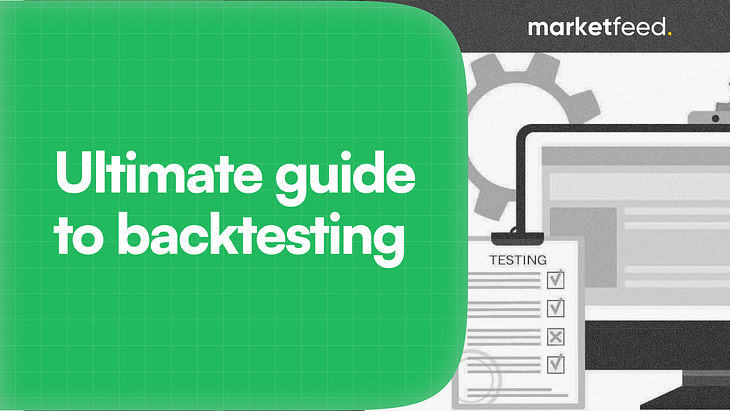The Ultimate Guide to Backtesting Algo Trading Strategies

Your success as an algo trader will ultimately depend on the strength and profitability of your trading strategies. However, simply creating a strategy isn’t enough; it’s essential to test and validate it before implementing it on live markets. This is where backtesting algo trading strategies come into play!
In this guide, we'll explore what backtesting is and provide a step-by-step approach to ensure your algo trading strategies are efficiently tested and optimised for success.
What is Backtesting? Why is it Important?
Backtesting is a process that allows traders to evaluate the performance of their trading strategies using historical market data. By doing this exercise, you'll get invaluable insights and opportunities to refine your strategies.
Suppose you're a coach or player in a football team. Every now and then, you would want to analyse your team's past performance to identify strengths, weaknesses, and areas for improvement. So think of backtesting like reviewing old video footage of a football match before an important game.
In this context, the historical market data is like the match footage and your trading strategy is the team's game plan or tactics. Instead of playing the actual game, you can "rewind" and simulate how your strategy would have performed in those past market conditions.
Let’s look at a simple example. Let's say you've developed a trading strategy that aims to capitalise on short-term price movements in the Nifty 50 index. Rather than risking your hard-earned money in the live markets, backtesting allows you to test your strategy on historical Nifty data. So you’re essentially rewinding the clock and observing how your strategy would have performed over a specific period!
Step-by-Step Guide to Backtesting Algo Trading Strategies
1. Define Your Trading Strategy:
The first step in backtesting is to outline the rules and parameters (conditions) of your trading strategy. This includes defining the entry & exit conditions, and risk management techniques (such as stop-loss orders or position sizing). Having a well-defined strategy is crucial for accurate backtesting and subsequent analysis.
[Position sizing is the process of determining the specific quantity or size of a financial asset (such as stocks, options, or futures contracts) that an investor or trader should buy or sell within their portfolio.]
2. Collect Historical Data:
You'll need to gather the necessary historical market data to backtest your strategy. This could include price data, volume data, and any other relevant indicators your strategy relies on. Ensure that the data is of high quality and relevant to your trading strategy and market.
For example, NSE’s website offers free historical index data for indices like Nifty 50, Bank Nifty, FIN NIFTY, etc. You can download the data in CSV format for specific timeframes. Explore third-party financial data providers like Bloomberg, Thomson Reuters, and Alpha Vantage to get a wider range of data points (these platforms offer paid plans).
3. Choose a Backtesting Platform:
Select a suitable backtesting platform or software that can handle your trading strategy and historical data. Remember to research and compare features, pricing, and suitability for your specific needs before choosing a platform!
TradingView and AlgoTest are examples of platforms that offer basic backtesting functionalities for beginners.
Also read: Why Should You Backtest Algo Trading Strategies?
4. Implement Your Strategy:
Code or program your trading strategy into the backtesting platform. You must ensure that it accurately reflects the rules and parameters you defined in Step 1. This step may require some programming knowledge, depending on the platform you choose.
Many user-friendly algo-trading platforms in India offer free and simple backtesting features. You can read more about it here.
5. Run the Backtest:
Execute the backtest by allowing the platform to simulate trades based on your strategy and the historical data you provided. By applying the rules of your strategy to the historical data, the platform will create hypothetical trades and monitor the resulting profit/loss, drawdowns, and other performance indicators.
6. Analyse Results:
Once the backtest is complete, evaluate the performance of your strategy by analysing important metrics such as:
- Profit/Loss: Analyse the overall profitability of your strategy and the distribution of winning and losing trades.
- Drawdown: Examine the maximum drawdown (the temporary decline or loss in the value of a trading account from its peak level before it recovers or reaches a new high). This can help measure the risk associated with your strategy.
- Sharpe Ratio: Calculate the Sharpe ratio, which measures the risk-adjusted return of your strategy. This ratio will help you compare your trading strategy's performance with other strategies or benchmarks.
A figure above 0.75 is generally considered to be a good Sharpe ratio. (This suggests that the strategy effectively manages risk while generating significant returns). - Other Metrics: You may also want to analyse metrics such as win rate, average trade duration, and the strategy's performance in different market conditions (e.g., bull vs. bear markets, high vs. low volatility).
7. Refine Your Strategy:
Use the insights gained from the backtesting analysis to refine your trading strategy. This may involve adjusting parameters (trade conditions), adding or removing filters, or modifying entry and exit rules. Your end goal must be to optimise your strategy for improved performance and risk management.
8. Repeat the Process:
After refining your strategy, we would always recommend you to repeat the backtesting process to evaluate the changes. Continue optimising until you are satisfied with the strategy's performance!
Bonus: Advanced Backtesting Techniques!
The steps outlined above provide a solid foundation for backtesting. However, there are several advanced techniques that can further improve the strength and validity of your strategy testing:
1. Out-of-Sample Testing
Assume you have a large box of historical market data. Instead of using the entire box to design and fine-tune your trading strategy, divide the data into two sections. You can use the first part (let's call it "in-sample" data) to explore, adjust, and optimise your strategy until it works well. The other part (the "out-of-sample" data) is like completely new data that you have never seen before.
After perfecting your strategy using in-sample data, you can move it to the second part to see how it performs on completely fresh, previously unseen data. This ensures that your strategy is not only overfitted to the data used to design it, but also capable of working well with new, unknown data.
2. Randomised Out-of-Sample Testing:
Going back to our previous example, instead of having only one in-sample data and one out-of-sample data, you can create other random data sets from your large box. Some of them can be used to refine your strategy (in-sample), while others are kept separate for testing (out-of-sample).
Then, you can test your trading strategy on each of these out-of-sample data sets. This ensures that your strategy can perform consistently well across multiple subsets of data, rather than simply one single out-of-sample set.
3. Walk-Forward Optimisation:
In this technique, you first use a small portion of your historical data (such as the in-sample data set) to create and refine your strategy. Next, you test your strategy on the next subset of data (the out-of-sample data set).
Instead of discarding the out-of-sample data after testing, you incorporate it into your in-sample data for the next round. You then use this updated in-sample data to further refine and optimise your strategy, and test it on the next out-of-sample portion.
This process continues, with the in-sample data growing larger and larger as you "walk forward" through your historical data. This approach helps ensure that your strategy is not overfitted to any specific subset of data and it can adapt/perform well as new data becomes available over time.
What is Portfolio Backtesting?
If you are developing a portfolio of multiple trading strategies, it's important to backtest the entire portfolio as a whole. This practice will help you assess the overall performance, risk profile, and potential diversification benefits of combining different strategies. Portfolio backtesting can help you determine the optimal weightings and allocations for each strategy. Thus, you can maximise your portfolio's risk-adjusted returns!
Live Trading
Once you are confident in your strategy's performance based on the backtesting results, it's time to deploy it in a live trading environment. However, it's crucial to approach live trading with caution and continuously monitor your strategy's performance. Always be prepared to make adjustments or refinements whenever necessary, based on real-world market conditions and observations.
Conclusion
After going through our guide, we hope it's clear that backtesting is an unavoidable step in developing and validating successful algo trading strategies. By thoroughly testing your strategies on historical data, you can gain valuable insights into their potential profitability, risk profiles, and areas for improvement. Moreover, the ultimate goal of backtesting is to develop well-optimised strategies that can navigate all market conditions with confidence and consistency!
Always remember that backtesting is a continuous process that requires patience, discipline, and a willingness to refine and adapt your strategies. By following the steps outlined in this guide, you can increase your chances of achieving long-term success in the world of algo trading!


Post your comment
No comments to display